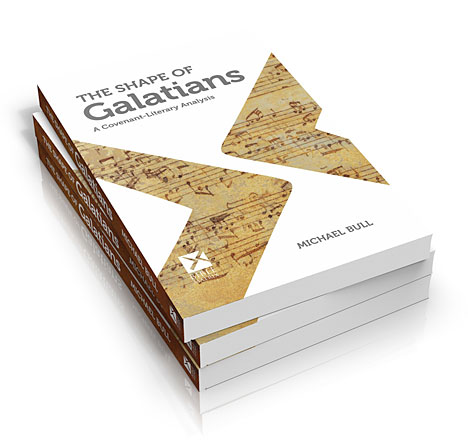Text As Image Bearer
The Shape of Galatians: A Covenant-Literary Analysis is now available on amazon. An ebook edition will follow shortly. As of writing, the ‘look inside’ function is not yet functional, but the introduction is as follows:
INTRODUCTION
This “musical” survey of Paul’s letter to the Galatians is probably nothing like any commentary you’ve seen before. And yet I believe this method of literary analysis gets us right inside the Apostle’s head and heart.
How foreign the clinical instruments of theology are to the lyrical texts of the Bible! At heart, Paul’s letter to the Galatians is neither a stream of propositional truth, nor a logical argument. Certainly, it communicates truth in a well-reasoned order, but it does so in a captivating “musical” form. There are symmetries, oppositions and references inscribed not in the text but built into its arrangement, right down to the order of the words in the Greek.
One of the channels of communication used by ancient authors was literary structure. The Bible takes this a step further and uses commonality of structure as a means of carrying on a profound and often entertaining internal conversation. Structure allows one text to allude to another not only implicitly, but with extreme efficiency. This method of writing was a convention practiced by every biblical author, including Paul.
The Apostle arranged all his texts in patterns drawn from the Hebrew Scriptures. Paul not only used words to convey meaning, but conferred greater meaning upon each word and phrase through its placement in relation to every other word and phrase.
Recognizing this aspect of Paul’s literature opens up to us new depths of meaning without contradicting what we see on the surface. In fact, this integrity between shape and content often serves to clarify his meaning, or explain his choice of words.
This convention also makes his prose instantly compatible with the rest of the Bible. By this, I do not mean that it agrees in doctrine, which it certainly does. This is the kind of compatibility which exists, by design, in telecommunications networks. Paul’s works do not merely sit within the Canon, like books on a shelf. Each is a flawless construction of sounds and images drawn from every corner of the Bible, tailored for a specific purpose yet ordered in exactly the same way. Bearing the same image as all the Scriptures, his phrases and sentences are actually plugged into a network, where each image-bearer, being unique, sheds light upon every other unique bearer of the same image. The structure makes his text an extension of the rest of the body, gives it an organic connection, and brings it to life. At a practical level, by composing his text in this way, Paul is able to bring all the Bible to bear upon the immediate situation through structural allusion. When Paul touches on something, he brings every corresponding literary and historical “node” in the Canon to light.
If this sounds unbelievable, it might help to understand that this is exactly what the Father does to us when He puts us “into” His Son, the one who fulfilled these patterns perfectly. Inspired literature bears the image of God.
Learning the “tune” sung consistently throughout the Bible not only enables us to understand it better, it also enables us to sing along. The “fractal” literature of the Scriptures is a divine marriage of mathematical method and poetic playfulness, structure and glory. It is music for the mind’s eye.
Or, if music is not your thing, reading the Bible with a musical sense is like spending hours on your surfboard. Experience builds you a schema of previous waves, so you not only “feel” the flow of the text as the flow of the ocean, you are able to make predictions about its behavior. You become one with the text as a surfer is one with the wave, or a musician one with the music. The participation becomes intuitive, which explains the (supposedly) unconventional use of the Old Testament by the authors of the New. They are not quoting texts as “direct” fulfillments. They are playing the same tune and showing us, with great delight, where we have heard it before.
The literary conventions and historical outcomes which shape the Old Testament are the tunes playing inside Paul’s head as he writes to the Galatians: the processes of God as expressed in the Creation Week, the testing of Adam, the order of the Canon, the Covenant documents, the festal calendar, the history of the Covenant people and even sacred architecture.
If we use these patterns as a lens through which to view his highly structured prose, Paul’s internal logic becomes immediately apparent, and the skillful allusions he makes to the Old Testament hammer home his message of freedom for us with greater depth and clarity than ever before.
This work is a “structural commentary.” It not only identifies the literary melodies and rhythms found in Paul’s letter to the Galatians, it allows similar patterns throughout the Bible, both before and after Galatians, to speak to their counterparts in this particular book.
(See Steven Opp’s review here)


























